| dc.contributor.author | Jacobsen, Tore | nb_NO |
| dc.date.accessioned | 2014-12-19T12:05:44Z | |
| dc.date.available | 2014-12-19T12:05:44Z | |
| dc.date.created | 2010-12-01 | nb_NO |
| dc.date.issued | 2010 | nb_NO |
| dc.identifier | 373787 | nb_NO |
| dc.identifier.uri | http://hdl.handle.net/11250/237769 | |
| dc.description.abstract | This thesis serves as a preparatory study for a new concept in subsurface towing proposed by Acergy Norway. 3 different mathematical methods for determining the most important dynamics occurring during a subsurface towing operation is therefore discussed and compared. The 3 models examined is a simple mass-spring system with forced excitations implemented in Matlab (chapter 6), a multibody time domain simulation in SIMO (chapter 7) and a model test for verification of results (chapter 9). The accuracy of the relatively simple hand calculations is discussed and compared to experimental values in chapter 10.
The first part of this thesis includes a description of different concepts for transportation of subsea templates to installation site. Transportation by subsurface towing instead of using a barge can reduce operational costs if the dimensions of the structure require a heavy-lift vessel. Also risk related to pendulum motions in air is reduced, and subsurface towing is therefore of great interest to marine contractors.
The most significant parameters to check by hand calculations in a subsurface towing operation is natural frequencies and modes of the dynamic system, and also estimates of the maximum/minimum loads lifting wires and slings. Since simple hand calculation models are of interest in early concept studies, formulas for these values are derived in chapter 6. These formulas are also found in (DNV Recommended practice H103, 2009).
SIMO is a time domain simulation program for multibody systems, which allows export of station keeping forces and connecting force mechanism (lifting wire and slings). Based on a system description file provided by Acergy Norway, a suitable model of the Gjøa ITS subsea template is made, and positioned 50 [m] below the moonpool hangoff point. Multiple analyses with different sea conditions and towing velocities have been done in SIMO to determine the feasibility and best practice of a subsurface towing operation.
In addition, a towing tank experiment was performed in Marine Cybernetics towing tank at Tyholt in Trondheim. A detailed model of the Gjøa ITS was made in 2008, and numerous previous experiments have been conducted (e.g Solaas(2008) and Eilertsen(2008)) which provided valuable information and reduced the required amount of work in planning a model experiment. In the experiment the template was towed with a vertical oscillator to simulate the vessel translation in head sea and forces were measured in the lifting wire. These model experiments were made for various environmental conditions, and compared to the numerical models previously described.
A correct representation of the towing arrangement in SIMO provides a relatively inexpensive model for further dynamic analysis of the system. A heave compensation device can easily be implemented in SIMO when the model of the vessel and template is correctly represented and can therefore be of valuable importance when designing a new conceptual hangoff-structure. | nb_NO |
| dc.language | eng | nb_NO |
| dc.publisher | Norges teknisk-naturvitenskapelige universitet, Fakultet for ingeniørvitenskap og teknologi, Institutt for marin teknikk | nb_NO |
| dc.title | Subsurface towing of a subsea module | nb_NO |
| dc.type | Master thesis | nb_NO |
| dc.contributor.department | Norges teknisk-naturvitenskapelige universitet, Fakultet for ingeniørvitenskap og teknologi, Institutt for marin teknikk | nb_NO |
